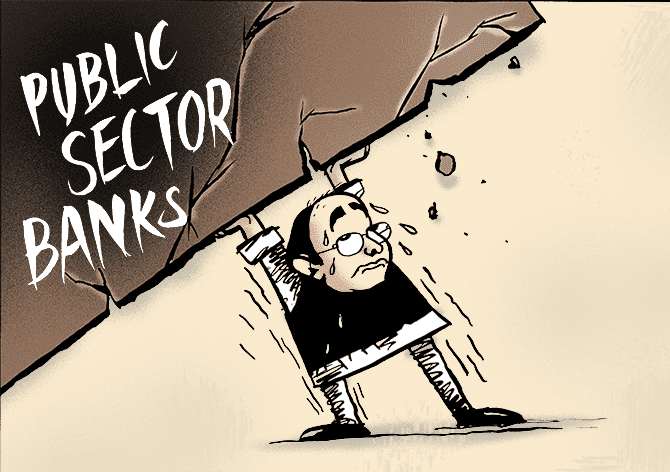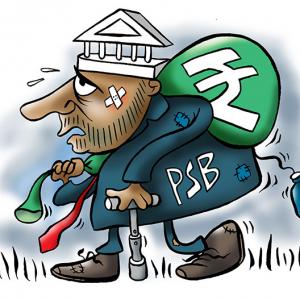'Today, bankers don't want to take risks as the good decisions taken by them were not protected.'
'There is risk involved in all decisions, like businessmen taking risks in their businesses.'
'A banker must have taken a decision when the economic condition was different, and you cannot question him on the basis of the present situation in hindsight.'
'Naturally, this has affected the morale of bankers.'

Illustration: Dominic Xavier/Rediff.com.
Last month the Centre announced that it would infuse over Rs 88,000 crore (Rs 880 billion) as capital in public sector banks, of which Rs 80,000 crore (Rs 800 billion) would be through recapitalisation bonds and Rs 8,139 crore (Rs 81.39 billion) in the form of budgetary support.
It was reported that IDBI Bank Ltd and Bank of India, which have been placed under prompt corrective action (PCA) by the Reserve Bank of India, will receive the highest capital infusion from the government at Rs 10,610 crore (Rs 106.10 billion) and Rs 9,232 crore (Rs 92.32 billion), respectively.
State Bank of India and Punjab National Bank, which are not under the PCA framework, will get Rs 8,800 crore (Rs 88 billion) and Rs 5,473 crore (Rs 54.73 billion), respectively.
Will this infusion of funds help public sector banks come out of the crisis?
"Recapitalisation is one of the most important aspects of revival and it is the role of the government, and they have done their duty," Kalyanaraman P R, below, director-south, Centrum Capital Ltd, tells Rediff.com/Shobha Warrier.
"What is needed to be done next is the resolution of stressed assets where additional capital is essential," adds Kalyanaraman who retired from the Bank of India as general manager after which he served as executive director at the Federal Bank.
Will recapitalisation help the banking sector overcome the huge non-performing assets problem?
It will definitely help the banking sector.
Based on the age of the NPA, the provisioning requirement keeps growing, and provisioning leads to the profit of the bank.
NPA means erosion of capital. Losses can be made good only from the capital or reserve, or even profit.
Improvement of profitability can also be made by way of reserve or by fresh infusion of capital.
Otherwise, you have to dip into the working capital fund which is the deposits, etc.
Will the recapitalisation amount be added to the capital or be used to reduce the NPAs?
It will go into the capital, and a part of the losses will be set off from the capital so that the capital is still adequate for them to carry on business operations.
If you look at the risk-based capital requirement as enforced by the Basel norms 1, 2 and 3, you will see that the capital requirement of banks are increased mainly to strengthen them against the possibilities of losses so that what happened in 2008 globally will not happen again.
The Indian banking system is robust because we have been strengthening the system gradually.
After liberalisation, capital was infused in banks and later on during the Manmohan Singh period also, additional capital was pumped in.
So, recapitalisation is nothing new to the banking industry.
Is it a common practice by governments to bail out PSU banks?
Not just PSU banks, governments bail out all banks because it affects millions of people.
If you remember, in 2008, the US government bailed out all the major American banks.
You should also remember that situations like these are not permanent; these are temporary phases.
As long as the government can support banks to come out of the difficult phase and if all the parameters mentioned in the Basel norms, like properly strengthening the management, following the regulatory norms etc, are followed diligently, it should not be a problem for the banks to come out of the difficult phase.
When I say this is a temporary phenomenon, it does not mean that all the assets owned by the borrowers are completely gone.
Yes, the assets are also undergoing a tumultuous period, but they may still be productive, but not productive enough to service the requirements.
The government also played a role in many instances for creating the stress.
For example, in the case of wind farms, national highway infrastructure etc.
Non-payment by government distribution outlets/NHAI was the reason why they ran into trouble.
The loss they suffered was not due to their own making alone.
Similarly, thermal power stations, gas-based power projects, cotton spinning units etc suffered due to sudden policy changes by the government.
What I want to say is, the mistake may not be because of the borrower alone.
So, it is necessary that we give a chance to all these people to recoup and come back.

However, wilful defaulters should be brought to book and made to pay so that the genuine borrowers are encouraged.
Yes, there are many instances of borrowers diverting money.
We have to understand that there could be many reasons behind an account going into difficulties and creation of NPAs in banks.
What someone borrows from the bank is public money, so if a unit is otherwise viable, and if he is supported during the difficult period, he will bounce back.
This way, we are safeguarding public money.
With so much money pumped into public sector banks, do you expect the lending cycle to start again and with that, economic growth too?
It will happen because a bank is expected to keep only minimum capital, which is the core capital or the tier 1 capital.
This is the strength of the bank and is made of equity and reserve.
Then comes the tier 2 capital consisting of bond etc which can only be a certain percentage of the tier 1 capital.
So, a bank has to have enough tier 1 capital to lend to people.
Basel has described quite well how much capital should be allocated to each type of risk which is called risk-based capital requirement.
So, a bank has to lend based on the guidelines given by Basel.
If the capital goes down, the bank will not be able to lend.
Now with the infusion of capital, the bank can once again start lending.
So, infusion of capital is aimed at encouraging banks to lend to create performing assets.
Is that why Moody's said this move would make weaker lenders credit positive?
Yes. How does a bank earn? The main earning has to come from interest. Other services are secondary.
Only bigger banks are active in treasury while smaller banks have lesser capacity to exploit the treasury.
Two years ago, when public sector banks were asked to declare their NPAs by the RBI, all the banks were in the red, and there was widespread panic saying the Indian banking sector was in a crisis.
With recapitalisation, will they come out of the crisis?
When a bank's capital got depleted, banks are wary of lending.
With this, their earning capacity also came down.
With additional capital, as I indicated earlier, banks can lend afresh, creating more performing assets and improve their situation.
If you wanted to revive a unit, you needed additional funds and banks did not have the capacity to lend further.
With capital infusion, banks will be in a position to evaluate the sick units again as to whether a unit is viable and can be revived.
If such units are revived, we will see an improvement.
When a unit turns around in a couple of years, the banks will start earning interest.
In other words, banks can create wealth out of the same NPA.
An account may be negative today, but it can start making profits and become a positive account for the bank tomorrow.
Is recapitalisation the only solution to help the banking sector suffering under the burden of huge NPAs?
Recapitalisation is one of the most important aspects of revival and it is the role of the government, and they have done their duty. This will have a positive impact on the banking sector.
But this is not the only solution. What is needed to be done next is the resolution of stressed assets where additional capital is essential.
The average NPA level in some banks had crossed 13% and when the capacity to lend improves, the NPA percentage also will come down.
Then the earning capacity of the banks improves, they can also look at lending to new industries.
The government spoke of the need to lend to the MSME sector and the maximum capital infusion is given to IDBI. Will that happen?
Yes. Till now, banks have been quite stringent in lending to the MSME sector.
When banks start lending to the small and medium units, it will have a huge impact on job creation.
Banks like IDBI and ICICI were initially called development banks and they were created to look at big industries and lend for their capital investment.
The commercial banks were there only to lend the working capital.
Then, these development banks were allowed to become commercial banks and start commercial lending.
Though the commercial banks were not created to lend to new projects, especially long-term infra projects as they didn't have the expertise, they were also allowed to lend to big projects as they had surplus of money.
In hindsight, we can say that both were not adequately prepared.
Now, everybody is expected to lend to the MSME sector to spread the risk.
For the government, this sector is very important as the maximum job creation -- about 60% -- is from this sector and not from the large industries.
When the performance of the banks improves, they can raise additional capital from the market.
Till now, they were not able to go to the public for raising additional capital because their performance was bad.
Banks can expect a double digit growth in credit as early as possible because single digit growth for a bank is very nominal.
If the economy has to grow, rate of growth in credit should also improve.
When that happens, banks will need more capital. The government cannot be infusing huge capital all the time.
That is when banks will have to go to the market for raising additional equity. That can happen only if they improve their performance.
So, the whole purpose of recapitalisation is to kickstart the entire process and hence a very positive and important move by the government.
How much time will it take for the economic cycle to start again?
The government plans to infuse capital by March. Because of this, banks can also present a better balance sheet in March.
Then, they can start lending from April onwards.
For the last 2, 3 years, banks were concentrating only on recovery and the culture of lending has gone down.
All the banks that were in the recovery mode have to move to the lending mode.
Today, if you go to a bank for borrowing money, they will not look at the proposal unless you have 100% collateral. Because of the previous bad experience, they are cautious.
So, banks have to come out of this mindset and adapt the culture of lending once again.
The mindset has to change from the top to the bottom.
At the same time, skill sets needed to lend that are lacking in the middle and lower level, have to be built.
I see fear of accountability in bankers. Politicians, bureaucrats and the media looked at bankers as the villain in the story, and they were unnecessarily haunted.
Today bankers do not want to take risks as the good decisions taken by them were not protected.
There is risk involved in all the decisions, like businessmen taking risks in their businesses.
Also, a banker must have taken a decision when the economic condition was different, and you cannot question him on the basis of the present situation in hindsight.
Naturally, this has affected the morale of the bankers, the lenders.
It means recapitalisation alone is not enough for the economic cycle to kick-start.
In my opinion, it will take at least a year for the whole process to settle down to show positive results.









